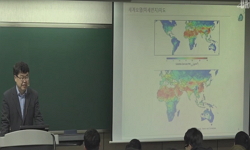도시화가 진행됨에 따라 대부분 도시의 중요한 과제로 부각된 초미세먼지(PM2.5)를 효과적으로 관리하기 위해서는 도시 구조와 기상 요소 간의 복잡한 상호작용을 분석하고 세밀하게 추정하...
http://chineseinput.net/에서 pinyin(병음)방식으로 중국어를 변환할 수 있습니다.
변환된 중국어를 복사하여 사용하시면 됩니다.
- 中文 을 입력하시려면 zhongwen을 입력하시고 space를누르시면됩니다.
- 北京 을 입력하시려면 beijing을 입력하시고 space를 누르시면 됩니다.

실측 자료를 활용한 ENVI-met 모델의 PM2.5 농도 정확도 검증 = Validation of PM2.5 Concentration Accuracy in the ENVI-met Model Using Field Measurements
한글로보기https://www.riss.kr/link?id=A109487905
- 저자
- 발행기관
- 학술지명
- 권호사항
-
발행연도
2024
-
작성언어
Korean
-
주제어
ENVI-met ; 초미세먼지 ; 미기후 ; 대기오염 ; ENVI-met ; PM2.5 ; Microclimate ; Air pollution
-
등재정보
KCI등재
-
자료형태
학술저널
- 발행기관 URL
-
수록면
1-19(19쪽)
- DOI식별코드
- 제공처
-
0
상세조회 -
0
다운로드
부가정보
국문 초록 (Abstract)
도시화가 진행됨에 따라 대부분 도시의 중요한 과제로 부각된 초미세먼지(PM2.5)를 효과적으로 관리하기 위해서는 도시 구조와 기상 요소 간의 복잡한 상호작용을 분석하고 세밀하게 추정하는 것이 필수적이다. 이를 위해서 모델링 프로그램이 활용되는데 그 중 ENVI-met이 다양한 미기후를 반영할 수 있고 식물의 표면에서 작용하는 대기오염물질의 침강 및 흡수를 분석할 수 있기에 PM2.5 농도 분석에 많이 쓰이고 있다. 그러나 국내에서는 실측값을 통한 검증 연구가 부족한 실정이다. 따라서 본 연구는 현장 측정 자료를 활용하여 ENVI-met 모델에서 예측되는 PM2.5 농도를 검증하고자 한다. 연구 결과, PM2.5 농도 예측은 전체 시간대에서 R2값이 0.479였으며 13시~16시의 오후 시간대에서 0.695로 가장 높은 상관성을 보였다. 이러한 결과로 ENVI-met 모델은 PM2.5 농도 변화를 신뢰성 있는 결과로 예측할 수 있다는 것을 확인하였다. 본 연구는 ENVI-met 모델의 예측값을 현장 측정값과 비교하여 검증함으로써, 향후 도시 내 PM2.5 관리에 있어 모델의 활용 가능성을 제시하였다.
다국어 초록 (Multilingual Abstract)
As urbanization progresses, fine particulate matter (PM2.5) has emerged as a significant issue in most cities. Effectively managing PM2.5 requires a detailed analysis of the complex interactions between urban structures and meteorological factors. To ...
As urbanization progresses, fine particulate matter (PM2.5) has emerged as a significant issue in most cities. Effectively managing PM2.5 requires a detailed analysis of the complex interactions between urban structures and meteorological factors. To achieve this, modeling programs such as ENVI-met are often utilized, as they can simulate microclimate and analyze the deposition and absorption of pollutants on plant surfaces, making them widely used in PM2.5 concentration analysis. However, studies validating these models with actual measurement data are lacking in Korea. Therefore, this study aims to validate PM2.5 concentrations predicted by the ENVI-met model using field measurement data. The results showed that the overall R2 value for PM2.5 concentration predictions was 0.479, with the highest correlation observed in the afternoon (13:00–16:00) with an R2 value of 0.695. These results confirm that the ENVI-met model can reliably predict changes in PM2.5 concentrations. By comparing the predicted values from ENVI-met with actual measurements, this study demonstrates the potential application of the model for future PM2.5 management in urban areas.
동일학술지(권/호) 다른 논문
-
항공초분광 영상 기반 한국 연안 갯녹음의 장기 변화 분석(2014-2023)- 항공초분광 영상 기반 우리나라 갯녹음 분석 -
- 한국지리정보학회
- 방건준
- 2024
- KCI등재
-
속성 그래프 기반 그래프 데이터베이스에서의공간 연산자 구현 방안 연구
- 한국지리정보학회
- 정승찬
- 2024
- KCI등재
-
공간적 군집분석 및 랜덤포레스트를 이용한 국도 동물 찻길 사고 핫스팟 영향요인 연구
- 한국지리정보학회
- 서현진
- 2024
- KCI등재
-
도시 특성별 탄소 배출량에 따른 유형별 탄소중립도시 조성방안
- 한국지리정보학회
- 오유진
- 2024
- KCI등재




 ScienceON
ScienceON KISS
KISS






